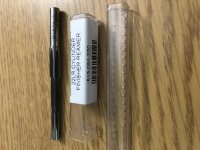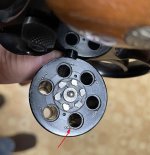max503
Member
I reamed the cylinders, then installed a Woulff factory replacement spring (not reduced power). I cleaned and lubed the innards. Mainspring tension screw is fully seated.
I checked end shake per the Larry Potterfield Youtube video. It measures .006.
What's my next move? Is there a way to measure firing pin protrusion? I don't think this gun has been fired much. It was made in 1958 and it's in like-new condition.
It averages 1-2 misfires per cylinder-full. The second hit sets them off.
I checked end shake per the Larry Potterfield Youtube video. It measures .006.
What's my next move? Is there a way to measure firing pin protrusion? I don't think this gun has been fired much. It was made in 1958 and it's in like-new condition.
It averages 1-2 misfires per cylinder-full. The second hit sets them off.
Last edited:



